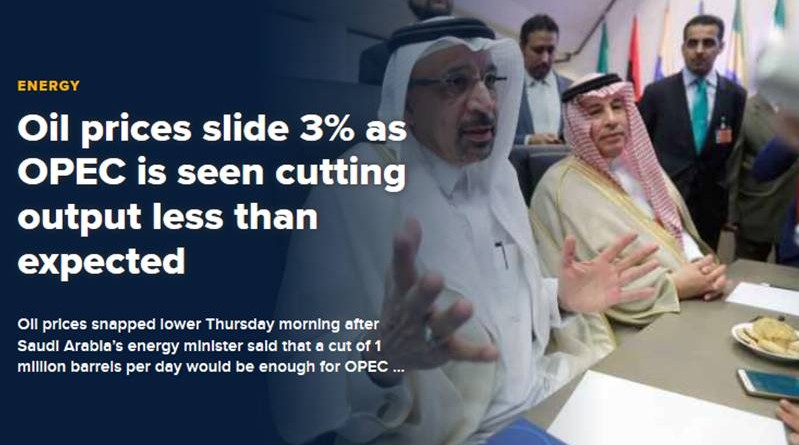Oil prices slide 3% as OPEC is seen cutting output less than expected
Oil prices tumbled nearly 5 percent on Thursday after comments from Saudi Arabia’s energy minister raised concerns that a fresh round of production cuts from OPEC, Russia and several other allied producers would not go far enough to tackle oversupply and boost the market.
OPEC is meeting at its headquarters in Vienna, Austria with the aim of reaching an accord over production levels for the next six months. Top OPEC producer Saudi Arabia has been leading calls for the group to trim output, amid surging supply and fears that an economic slowdown will erode fuel demand.
Oil producers appeared to be coalescing around a plan to remove 1.3 million barrels per day from the market earlier in the week. However, Saudi Energy Minister Khalid al-Falih told reporters on Thursday morning that a cut of 1 million bpd would be sufficient.
International benchmark Brent crude fell $1.59, or 2.6 percent, at $59.97 a barrel around 8:15 a.m. ET (1315 GMT), after falling to a session low at $58.36. U.S. West Texas Intermediate crude was down $1.59, or 3 percent, $51.30, bouncing from a session low of $50.23.
The two benchmarks have fallen more than 30 percent over the last two months. The oil price has been hammered by concerns that supply will outstrip demand next year, weakness in global markets and technical trading that has extended the selling.
Falih said a production cut of 1.3 million barrels per day is “excessive” in light of Alberta’s decision this week to cut 325,000 bpd in order to drain the Canadian province’s brimming stockpiles of crude. Falih also noted that production from some OPEC producers is falling.
“The number that we need is going to be less than 1.3 [million]. Is it a million? Is it slightly less, slightly more? We have all day today and some of tomorrow to determine those numbers.”
Some energy analysts questioned whether a reduction of 1 million barrels per day is adequate to balance supply and demand in 2019, especially considering that key producers including Saudi Arabia, Russia and Iraq have been increasing output.
“Given the recent ramp-up in supply from these producers, this represents a year-on-year decline in crude output of just 0.2 million barrels per day for 2019,” Ann-Louise Hittle, vice president for macro oils at Wood Mackenzie, said in a briefing.
“We continue to expect world oil demand growth to average close to 1.1 million barrels per day in 2018 and 2019. This sits against a backdrop of rapid non-OPEC production growth — 2.4 million barrels per day year-on-year in 2018 and 2019, due mostly to gains in the US output over both years.”
Falih added that the kingdom is comfortable with the current oil price but confirmed there had been no decision on an output cut yet.
OPEC is thought to be waiting on Russia before deciding the exact level of production cuts and talks are likely to run into Friday’s session. Five unnamed delegates told Reuters ahead of the meeting that the group’s preferred level of supply cuts would effectively be conditional on Moscow’s contribution.
Russian Energy Minister Alexander Novak was quoted saying Thursday morning that it would be “much more difficult” for Moscow to cut oil output over the winter because of the cold conditions at Russian oil fields.
OPEC began managing crude supply in partnership with Russia and several other nations last year in order to end a punishing downturn in oil prices. The Middle East-dominated group produces has a long history of adjusting production to guide the energy market.
SOURCE: CNBC




